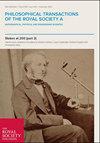Development and implementation of the effective force testing method for seismic simulation of large–scale structures
Philosophical Transactions of the Royal Society of London. Series A, Mathematical and Physical Sciences
Pub Date : 2001-09-15
DOI:10.1098/rsta.2001.0879
引用次数: 44
Abstract
This paper describes the development and experimental implementation of a real–time earthquake simulation test method for large–scale structures. The method, effective force testing (EFT), is based on a transformation of coordinates, in which case the structure is fixed at the base (similar to the set–up for the pseudo–dynamic (PsD) test method); however, in the case of EFT, the method is based on a force–control algorithm rather than a displacement–control algorithm. Effective forces, equivalent to the mass of each storey level multiplied by the ground acceleration, are applied at each respective storey. As such, the EFT forces are known a priori for any ground acceleration record. As opposed to the PsD test method in which the ground displacements to be imposed are affected by the measured structural response as the stiffness changes. As in the case of the PsD test method, the EFT method is suitable for testing any type of structural system that can be idealized as a series of lumped masses (e.g. building or bridge structures). Research has been conducted on a linear elastic single–degree–of–freedom system at the University of Minnesota to develop and investigate implementation of the EFT method. A direct application of the EFT method was found to be ineffective because of a natural velocity feedback phenomenon between the actuator and the structure to which it is attached. A detailed model of the control, hydraulic and structural systems was developed to study the interaction problem and other nonlinear responses in the system. The implementation of an additional feedback loop using the measured velocity of the test structure was shown to be successful at overcoming the problems associated with actuator–ndash;control–ndash;structure interaction, indicating that EFT is a viable real–time method for seismic simulation studies.大型结构地震模拟有效力测试方法的开发与实现
本文介绍了大型结构实时地震模拟试验方法的研制和试验实现。有效力测试(EFT)方法基于坐标变换,在这种情况下,结构固定在基座上(类似于伪动力(PsD)测试方法的设置);然而,在EFT的情况下,该方法是基于力控制算法而不是位移控制算法。在每一层上施加的有效作用力等于每一层的质量乘以地面加速度。因此,对于任何地面加速度记录,EFT力都是已知的先验。与PsD测试方法相反,在PsD测试方法中,随着刚度的变化,要施加的地面位移受到测量结构响应的影响。与PsD测试方法一样,EFT方法适用于测试任何类型的结构系统,这些结构系统可以被理想化为一系列集中质量(例如建筑物或桥梁结构)。明尼苏达大学对一个线性弹性单自由度系统进行了研究,以开发和研究EFT方法的实现。由于执行器与其所附结构之间存在自然的速度反馈现象,因此发现直接应用EFT方法是无效的。建立了控制系统、液压系统和结构系统的详细模型,研究了系统中的相互作用问题和其他非线性响应。利用测试结构的测量速度来实现额外的反馈回路,成功地克服了与致动器、控制器和结构相互作用相关的问题,这表明EFT是一种可行的实时地震模拟研究方法。
本文章由计算机程序翻译,如有差异,请以英文原文为准。
求助全文
约1分钟内获得全文
求助全文
来源期刊
自引率
0.00%
发文量
0

 求助内容:
求助内容: 应助结果提醒方式:
应助结果提醒方式:


